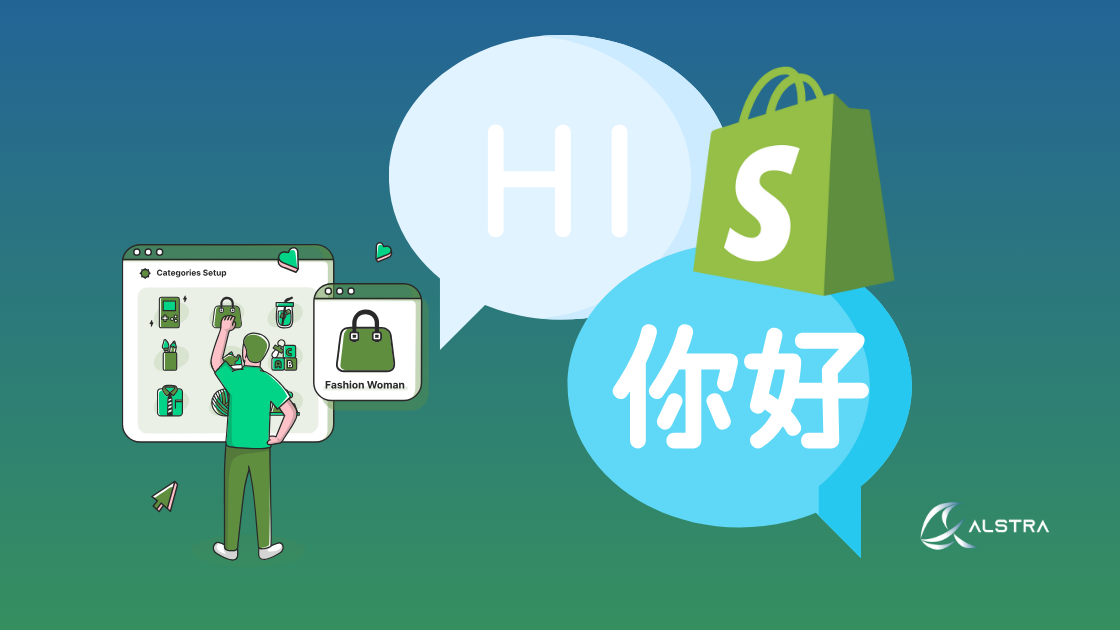Why Is a Bilingual English-Chinese Shopify Store Essential for Canadian E-commerce Success in 2025?
Operating a bilingual English-Chinese Shopify store has become a strategic need rather than only a nice-to-have advantage in the Canadian market of today. For e-commerce companies, Canada’s multicultural scene features a sizable Chinese-speaking community that offers a lucrative clientele.
Research shows that multilingual websites attract more customers and foster deeper engagement, as people naturally prefer browsing and shopping in their primary language. According to the Canadian Internet Registration Authority (CIRA), offering content in multiple languages significantly improves search engine rankings and reduces bounce rates, as customers are more likely to engage with content in their preferred language.
Furthermore, a bilingual approach demonstrates inclusivity and professionalism, which resonates strongly with Canada’s diverse society. This approach not only expands your customer base but also builds trust and loyalty among Chinese-speaking customers who might otherwise feel excluded by English-only sites.
How Does Canada’s Bilingual Market Demographics Impact Your Online Store Strategy?
The linguistic variety of Canada goes much beyond the proclaimed English and French bilingualism. The nation welcomes Punjabi, Tagalog, many more languages, Chinese (both Mandarin and Cantonese), and sizable populations speaking these languages. This variety influences the development of e-commerce strategy directly
According to Canada’s international education strategy, multilingual websites are essential for attracting more customers and fostering deeper engagement. Parents and influencers in immigrant communities often prefer content in their primary language, which significantly affects purchase decisions.
A bilingual approach aligns perfectly with Canada’s national branding strategy, which emphasizes linguistic duality and multiculturalism to attract international audiences. To succeed in this environment, digital strategies must be inclusive and carefully coordinated to reach all key demographic segments effectively.
Which Shopify Themes Best Support Multilingual Functionality for English and Chinese Content?
When selecting a theme for your bilingual store, you’ll be pleased to know that all free Shopify themes are compatible with multilingual features, including support for both Simplified and Traditional Chinese. This compatibility makes the initial setup relatively straightforward.
If you prefer using custom themes, these can also support multiple languages but may require updates or developer support to ensure full compatibility. Shopify’s built-in localization features allow for easy translation of theme content, checkout processes, and system messages into Chinese.
The platform’s robust theme architecture ensures that your store maintains a consistent visual identity across language versions while providing a seamless user experience for all visitors.
What Native Shopify Apps Provide the Most Reliable Language Translation Capabilities?
Shopify’s native “Translate & Adapt” app has emerged as the most reliable solution for language translation within the Shopify ecosystem. This app allows automatic translation into two languages for free and offers manual translation capabilities for unlimited languages.
One of the key advantages of Translate & Adapt is its integrated side-by-side editor, which facilitates reviewing and adapting content to ensure cultural relevance. The app supports both Simplified and Traditional Chinese, making it suitable for targeting various Chinese-speaking demographics.
For most retailers, this software offers a simple and dependable experience since it is directly connected to the Shopify administrative interface, therefore removing compatibility problems that might result with outside solutions.
How Do Third-Party Translation Tools Compare to Shopify’s Built-in Language Features?
While Shopify’s built-in tools like Translate & Adapt offer seamless integration, basic AI-powered translation, and easy manual editing, third-party apps often provide more advanced features that may be necessary for more complex multilingual stores.
Apps such as Langify, LangShop, and Translation Lab offer enhanced capabilities including support for more languages and dialects, dedicated language-specific URLs for improved SEO, and automatic language detection for a more personalized user experience.
Third-party apps, however, could need extra setup and could possibly affect site speed or compatibility if not carefully selected. Your particular company needs, technical capacity, and financial restrictions will help you decide between native and outside solutions.
When Should You Choose AI Translation vs. Human Translators for Your Product Descriptions?
The choice between AI translation and human translators represents one of the most significant decisions for your bilingual store. Each approach has distinct advantages depending on your content type and business goals.
AI translation excels with high-volume, repetitive, or technical content where speed and cost efficiency are priorities. This makes it suitable for product descriptions and FAQs. AI solutions can achieve 70-85% accuracy, especially when enhanced with translation memory and glossaries. This approach allows for rapid deployment across large inventories.
In contrast, human translators remain essential for marketing copy, culturally sensitive material, legal documents, or any content where nuance, tone, and cultural context are critical. Human translation generally provides 95-100% accuracy and ensures cultural fit, which is particularly important when appealing to Chinese-Canadian consumers.
Many successful businesses implement a hybrid approach: using AI for initial drafts and human review for final editing. This strategy combines the speed and cost-efficiency of AI with the quality and cultural sensitivity of human translation.
What Cultural Nuances Must Canadian Retailers Consider When Marketing to Chinese-Speaking Customers?
Understanding cultural nuances is paramount when targeting Chinese-speaking customers in Canada. Chinese consumers often place high value on brand loyalty, trust, and references to tradition, reflecting a more past-oriented cultural perspective than typically seen in Western marketing.
Your messaging should respect and reflect family values, community connections, and social proof—all powerful motivators in Chinese consumer culture. It’s also crucial to recognize that language preferences vary significantly among subgroups (Mainland China, Hong Kong, Taiwan), making it important to understand dialect and regional differences.
A common pitfall to avoid is the direct translation of idioms or humor that may not translate well culturally. All content should be culturally adapted, not just literally translated, to create authentic connections with Chinese-speaking customers.
How Can You Implement Effective SEO Strategies for Both English and Chinese Content?
Using efficient SEO for a bilingual store calls for specific strategies outside of conventional wisdom. To tell search engines which language version to show consumers, utilize hreflang tags, therefore avoiding duplicate content problems and enhancing local search results.
Conduct region-specific keyword research rather than simply translating keywords. Identify search terms actually used by Chinese-speaking Canadians, which may differ significantly from direct translations of English keywords.
Ensure each language has a separate, indexable URL structure (e.g., /en/ and /zh/) to help search engines properly categorize and rank your content. Additionally, localize meta tags, alt text, and structured data for both languages to maximize visibility.
Working with native speakers to review content for cultural and linguistic appropriateness is not just good practice for user experience—it’s essential for SEO success in multilingual environments.
What Payment and Shipping Solutions Best Serve Both Language Demographics in Canada?
To effectively serve both English and Chinese-speaking customers, your payment and shipping solutions must accommodate the preferences of both demographics. Shopify supports multiple payment gateways popular with both customer groups, including standard credit cards, PayPal, and region-specific options.
For products sourced from China, ePacket shipping has emerged as a reliable solution, offering faster delivery times, tracking capabilities, and transparent pricing—all key elements for cross-border e-commerce targeting Chinese-speaking customers.
Clear communication about shipping methods, costs, and customs information in both languages is essential to build trust and reduce cart abandonment. This transparency is particularly valuable for Chinese-Canadian customers who may be comparing your offerings with those from familiar retailers in China.
How Should You Measure and Optimize the Performance of Your Bilingual Shopify Store?
Measuring and optimizing performance requires a data-driven approach that considers the unique aspects of a bilingual store. Use Shopify’s built-in analytics and speed reports to monitor site performance, load times, and customer engagement for each language version separately.
Track SEO metrics—including traffic, bounce rate, and conversion rate—for both English and Chinese pages using tools like Google Analytics and Search Console. This segmented analysis can reveal important insights about how different language groups interact with your store.
Review user behavior patterns often and, depending on these data-driven insights, modify language options, navigation, and content. Maintaining good performance and customer satisfaction over both language versions depends on constant testing and improvement of translations, site speed, and user experience.
Ready to Launch Your Bilingual Shopify Store? Let Alstra Solutions Guide You
A bilingual English-Chinese Shopify store represents far more than a technical upgrade—it’s a strategic necessity for Canadian retailers aiming to thrive in today’s multicultural, digitally-driven market. By leveraging Shopify’s native tools, understanding Canada’s unique demographics, and respecting cultural nuances, you can maximize your reach, enhance your reputation, and increase revenue in 2025 and beyond.
At Alstra Solutions, we specialize in transforming this multilingual vision into reality. As a federally registered IT firm based in Toronto and an official Shopify partner, we understand the nuances of creating effective bilingual e-commerce experiences. Our comprehensive services go beyond website development to include customized design, long-term maintenance, SEO optimization, and intelligent traffic analysis—everything you need for a successful bilingual online presence.
Our multicultural team brings both technical expertise and cultural awareness to every project, ensuring your store resonates with both English and Chinese-speaking customers. Ready to expand your reach in Canada’s diverse marketplace? Contact us today to discuss how we can help you build a bilingual Shopify store that drives growth and connects with new customers.

